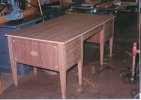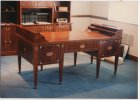Parker is correct in his statement that true mahogany is from the Americas. Swietenia macrophylla, or Honduran mahogany, is the most commonly available species, but availability is dwindling. Perhaps the most desirable of the true mahoganies is Swietenia mahoganii, or Cuban mahogany. It is rare and expensive if you can find it. African mahogany is more a marketing name and can refer to one of several different species from Africa. Khaya ivorensis is one of the most common species referred to as African mahogany. It can be a bit difficult to work with as it has an interlocking grain that tears out easily, requiring careful prep prior to finishing. Sapele, or Entandrophragma cylindricum, is sometimes marketed as African mahogany as well. It has a grain that is very similar to the true mahoganies, and is a bit darker in color, although there are lighter and darker varieties.
I also agree with Bob that to the casual observer, the differences between all of the above mentioned species would be unnoticeable. I have worked with all of these woods, with the exception of Cuban mahogany, over the past 40 years. As a substitute for true mahogany, I prefer sapele. It is easy to work and finish. It is less expensive and easier to source, and it takes an expert eye to distinguish it from true mahogany. To be honest, I don't think that I would be able to distinguish it in a finished piece.
I hope this helps some.
Matt


